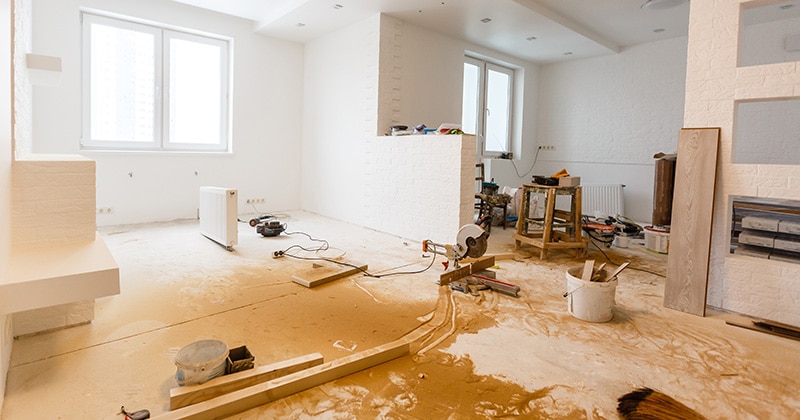There are well over half a million remodeling businesses in the U.S. That number is only growing. The good thing is that the demand for residential remodeling services increases year after year. But still, the home remodeling space is fiercely competitive.
Competing in a tough industry calls for an aggressive marketing strategy. Forget the trial-and-error approach. What you need is a marketing plan that makes your brand stand out. That’s what this article is all about—taking your home remodeling marketing to the next level.
Let’s talk marketing strategies. We’ll discuss targeting the right audience, devising a solid marketing plan, going digital, and more.
FROM ONE OF OUR PARTNERS: How to Market a Remodeling Business
Research and Understand Your Target Audience
The first task in any marketing strategy is understanding the target audience. Your target audience will form your core customer base. These are the people who are most likely to buy your remodeling services. They should be the subject of your marketing campaigns.
Create a persona for your ideal customer. Do so by investigating the following attributes of your target audience:
- Where do they live?
- How old are they?
- Do they have families and kids?
- How much do they earn?
- Where do they socialize?
- Are they homeowners, tenants, realtors, or flippers?
- What are their pain points or challenges when it comes to home remodeling?
- Have you remodeled for them before?
- What are their interests and hobbies?
For example, the ideal customer for your remodeling services could be a homeowner between the ages of 30 and 55 living within a 25-mile radius who is looking to remodel their kitchen with a budget between $40,000 and $60,000.
Why Is a Target Audience Important?
Studying your target audience is the crucial first step in successful marketing.
Identifying and studying your target audience takes the guesswork out of marketing. Once you’ve determined your target audience, you can fine-tune your marketing efforts for that specific market segment. Not only that, but you can also even design your offerings to appeal to a particular niche.
Understanding your target remodeling audience helps your marketing in the following ways:
- Defines the marketing approach to use
- Tells you the best marketing channels and content to reach your audience
- Helps you identify exploitable gaps or niches in the market
- Gives you insights into the competition
- Focusses your marketing efforts, making them more efficient and effective
- Enables you to profile potential customers in terms of preferences, spending habits, and likelihood to buy
In a nutshell, understanding your target audience directs your marketing strategies. It tells you where and how to spend your resources connecting with people likely to contract your business. Think of it as putting a target in your sights.
RELATED ARTICLE: Home Remodeling Leads: 6 Ways to Get More Leads

Craft a Comprehensive Marketing Plan
You need a well-defined plan for reaching out to potential customers. A marketing plan is a strategic roadmap outlining your marketing course of action. It details your marketing activities for a given period. That period could be a year, quarter, or season.
Here’s a step-by-step guide to drafting a remodeling marketing plan:
Step 1: Define Your Marketing Goals and Objectives
All good plans lead to preset goals. What’s the goal of your marketing plan? You won’t get anywhere unless you know where you’re going.
The ultimate marketing goal is to “sell more.” But you need to be more specific than that.
A comprehensive marketing plan usually includes multiple strategies with different objectives. Some of the goals might have nothing to do with sales at all.
Here is a list of marketing goals to keep in mind when drafting your plan:
- Increase brand awareness.
- Generate remodeling leads.
- Launch a new service or product.
- Retain existing customers.
- Boost online following.
- Increase customer engagement.
- Establish, grow, or repair brand reputation.
- Outdo competitors.
- Improve customer lifetime value.
- Convert leads into paying clients.
Your marketing goals must align closely with your company’s mission. Also, ensure all your goals are SMART:
- Specific
- Measurable
- Attainable
- Relevant
- Time-Bound
Remember, there’s a fine line between realistic goals and wishful thinking.
Step 2: Identify and Segment Your Buyer Personas
We’ve already talked about identifying the target audience. Doing so is a vital part of your marketing plan.
Keep in mind that your marketing plan can have multiple target audiences. For example, you can use different marketing strategies to target new homeowners, family homes, property investors, etc.
Step 3: Size Up the Competition
Marketing is a battle. When going into battle, you need to know who you’re up against.
Identify other remodelers in your service area. Analyze their strengths and weaknesses. No matter how small, every competitor poses a threat to your business.
However, the threat may differ from competitor to competitor.
For instance, one competitor may dominate a specific market segment. Another is well-known for low prices. Analyze the different threat levels to gauge where your brand stands in the market.
There’s a lot to learn by studying your competition. You can identify an underserved niche. You may also find untapped strengths in your own business simply by observing competitors.
Understanding the competition gives you a marketing angle. See what other remodelers are doing. Then, you can cleverly position your brand to stand out.
Step 4: Determine Your Unique Value Proposition
After analyzing the competition, ask yourself what you bring to the market. How is your business different from other remodeling contractors?
Find your unique value proposition, and wrap your marketing plan around it.
A unique value proposition or selling point sets your business apart. It’s a business attribute guaranteed to win you favor in your target market.
Your unique value proposition could be:
- Affordable remodeling services
- High-quality remodeling work
- Flexible payment plans
- Exceptional remodeling styles, skills, or expertise
- Qualifications to work on certain buildings or in certain municipalities
- Customer satisfaction guarantees
- Seasonal or one-time offers
- Quick turnaround on remodeling projects
- Proprietary building materials or methods
Step 5: List Your Key Marketing Channels
Having written the plan this far, you should have a pretty good idea of how to market your business. It’s the culmination of everything you’ve done so far.
You know where to find your audience. You have the message you want to put across. You see what you want to achieve. It’s just a matter of bringing all that together.
There are several marketing channels at your disposal. Each channel has its pros and cons. Some will work better than others. The trick is finding the most efficient and effective strategies.
Here’s a list of marketing channels that work for remodeling contractors:
- Company website
- Search engine marketing
- Social media
- Snail mail
- Ads on buses, benches, bus stop shelters, streetlight poles, and billboards
- Signage on company vehicles, equipment, attire, and premises
- Print media
- Referral programs
- Broadcast media (local TV, radio, podcasts, etc.)
Step 6: Set a Budget
How much are you ready to spend on marketing? For small businesses, the general rule is to spend 7 to 8% of gross revenue on marketing. But contractors spend, on average, 3% of their income on marketing. So, which is it?
First of all, don’t take these figures to heart. The amount you spend on marketing will vary widely depending on the channel used. It also matters how aggressive the campaign is. In other words, the marketing budget is relative and unique to every business.
Go with what makes sense for your marketing goals and financial muscle. Work out how much it’ll take to achieve your goals through your chosen marketing strategies.
But don’t put all your eggs in one basket.
When allocating resources to your marketing plan, apply the 70-20-10 rule. Spend 70% of the budget on marketing strategies that have proven to work. Allocate 20% to efforts that are effective but uncertain. And the remaining 10% goes to untested strategies.
The 70-20-10 rule helps you place a safe bet on marketing spend. It also gives you some room to experiment with new marketing ideas.
Step 7: Track Marketing Performance
It’s important to track your marketing performance. Tracking tells you where your marketing efforts are headed.
Remember the goals and objectives you set when starting your marketing plan? Those should now define your marketing key performance indicators (KPIs). Measure your KPIs regularly. This will help gauge the efficiency and effectiveness of your marketing strategies.
Crucially, performance tracking indicates what works and what doesn’t work. From there, you can prioritize strategies that work. Then, modify the marketing plan accordingly.
Leverage Digital Marketing Channels Effectively
The internet is a powerful marketing medium. It’s the basis for digital marketing. And it’s not just for online businesses either. It also works for local brick-and-mortar establishments.
According to one report, 76% of consumers research businesses online before visiting them in person. And nearly half (45%) are likely to visit a local business after finding it online.
Digital marketing gives you access to a large and diverse audience. On top of that, digital channels have relatively high ROIs.
They are also easy to track and scale. Digital marketing can be used for just about anything. Promote everything from brand awareness to lead generation.
Going digital is a must when taking your remodeling marketing to the next level. Let’s look at five ways of doing just that:
FROM ONE OF OUR PARTNERS: 4 Digital Marketing Tips for Remodeling Contractors
Launch a Remodeling Website
Launch a well-designed, search-engine-optimized remodeling business website. This should be ground zero for your online presence.
The website should attract potential remodeling customers and tell them about your business. However, not just any website will do. Ensure your site has the following features and capabilities:
Optimized for local searches.
All pages should have content, URLs, title tags, headers, and meta descriptions relevant to remodeling-related queries in your service area.
Designed for smartphones.
Over 90% of internet users access the web via smartphones. A marketing website must be accessible, responsive, and fully functional on mobile browsers.
Peppered with contact details.
Display your business’s name, address, phone number, and email address clearly on every page.
Enriched with customer engagement features.
Engage potential remodeling customers through a blog, live chat, quote estimate calculator, or other interactive features.
List Your Business on Google
Google Business Profile (GBP) is a free online directory for local businesses. All you have to do is fill in your profile and wait for the magic to happen.
Once on GBP, your listing stands to appear in organic results for remodeling-related searches. The local business listings section or the Local 3-Pack is a magnet for leads. GBP listings have an average click-through rate of about 16%.
Utilize Your Email List
Email marketing is a proven lead generation and customer retention strategy. It also has the highest ROI of any marketing channel. Every dollar spent on email marketing returns a whopping $36.
Here’s the basic structure of email marketing:
- Collect email addresses from existing and potential clients. You can do this via your website or social media pages. You may even use business documents (job quotes, invoices, job cards, etc.).
- Segment the email list. Base segments on each contact’s likelihood to buy and position in the customer journey.
- Start emailing each contact personalized messages.
- Track the campaign’s performance. Measure open rate, click-through rate, list growth, bounce rate, and conversion rate.
Emailing can be tedious when done manually. It helps to have an in-house digital platform to manage emails and email lists. MarketSharp is one such platform. It lets you automate email marketing, nurture leads, gather customer insights, and more.
Get Social.
There are 5.04 billion social media users around the world. That’s about 60% of the global population. This large audience makes social media a hotspot for digital marketing.
Getting on social media is a great way to increase your exposure, traffic, leads, client base, and sales. You can do so organically or by utilizing promotional features on social platforms.
Ensure your remodeling business has an active presence on the big social platforms. We’re talking Facebook, Twitter, Instagram, Nextdoor, and LinkedIn.
Try Paid Ads.
Paid ads are another effective way to boost your online presence. If you’re considering paid online ads, you can’t go wrong with Google’s Local Services Ads. These are pay-per-lead ads specifically designed for service-based businesses operating locally.
Pay-per-lead ads are cost-effective. You only pay once someone contacts your business via the ad.
Additionally, social media platforms support paid ads in one form or another. For instance, Facebook offers several types of ads, including messages, images, and carousel ads.
FROM ONE OF OUR PARTNERS: 5 Quick Tips for Marketing Your Remodeling Business on Social Media
The Next Level: 5 Marketing Ideas You Can Use Today
What are you waiting for? Elevate your marketing game today. In addition to what we’ve discussed, here are some ideas to get you started:
Double Down on Content Marketing.
Content is king. There’s no doubt about that.
Create blog, video, and social media content that appeals to your target audience. Relevant, well-crafted content will boost customer engagement, online traffic, and lead generation.
Attend Local Events.
Start attending local events. Find sporting events, builders’ conventions, charity events, trade fairs, award ceremonies, rallies, parades, etc.
You could even sponsor such events. Participating in local activities puts your brand name right in front of your target audience.
Incentivize Sales.
Give customers a reason to contract your business for remodeling projects. You can drum up business by offering discounts to first-time customers. A referral program is also great for bringing in new remodeling clients.
Partner with Popular Brands.
Partnering with a familiar and reputable construction company or supplier can boost your credibility. An endorsement from a respected brand in the industry could even be your unique value proposition.
This can be a game-changer if you’re a newbie in the market looking to score some trust points.
Hire an Influencer.
Ask a local or online celebrity to become your brand ambassador.
An ideal influencer could be a home improvement contractor, realtor, or home financing institution. They can spread the word about your remodeling business and “influence” their followers/customers to contact you.
Ready to learn more about managing your remodeling business more efficiently? Schedule a demo today.

